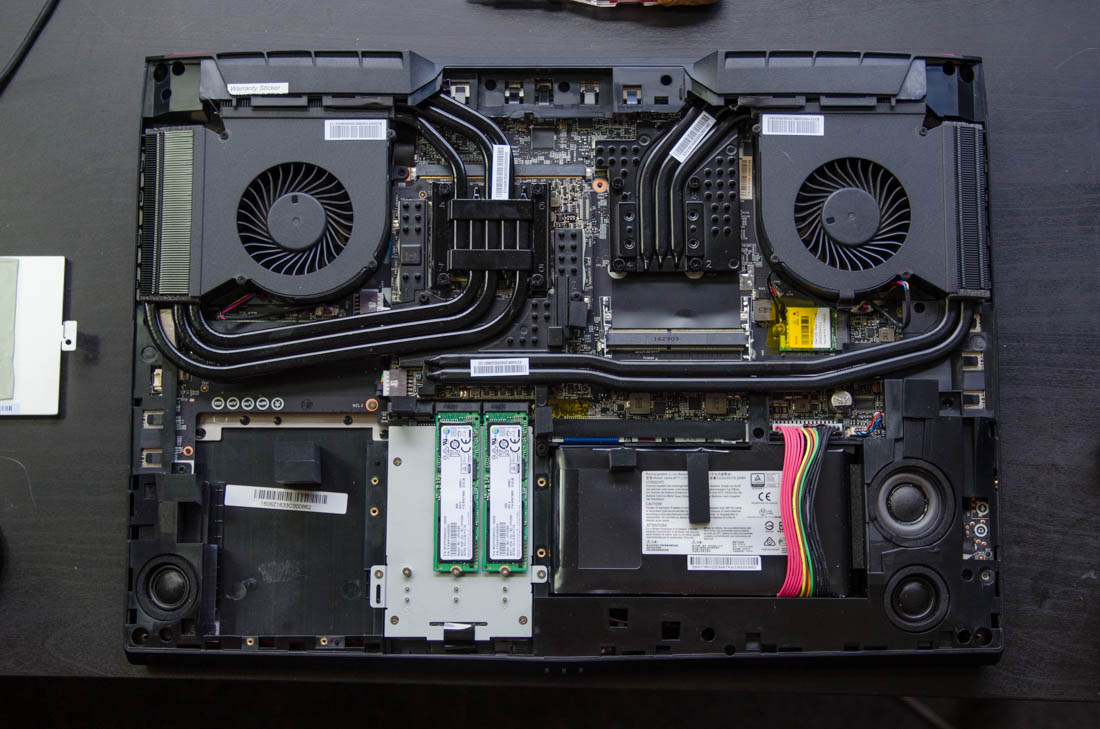MSI GT73VR Titan Pro Review > Hardware Overview
Hardware Overview
There are a ton of configuration options bachelor for the GT72VR encompassing cost ranges from $ii,100 to above $3,500. In that location are far also many to sensibly listing in this article, so I've highlighted some choice configurations that signal what you can become for diverse prices.
- GTX 1070, 16GB RAM, 128GB SSD, 1TB HDD, 1080p display - $ii,078
- GTX 1080, 16GB RAM, 128GB SSD, 1TB HDD, 1080p display - $ii,599
- GTX 1070 SLI, 32GB RAM, 256GB SSD, 1TB HDD, 1080p display - $2,769
- GTX 1080, 32GB RAM, 512GB SSD, 1TB HDD, 1080p display - $3,099 – Reviewed!
- GTX 1080, 64GB RAM, 1TB SSD, 1TB HDD, 4K brandish - $3,749
Upgrading to the GTX 1080 from the GTX 1070 base of operations model volition cost you lot $500, while upgrading to two GTX 1070s in SLI costs just under $700 (plus you also get double the RAM and SSD space). Going from a 1080p 120Hz display to a 4K display costs $200.

If you're looking at RAM and SSD upgrades, these vary in cost quite a chip, and options like 64GB of RAM actually aren't worth the money in a gaming organization. Information technology's likewise important to keep in mind that the GT73VR is hands user upgradeable, and at that place are enough of extra slots available for additional SSDs. Information technology may be cheaper to merely upgrade this laptop yourself, although doing and then volition void the warranty.
All GT73VRs come equipped with Intel'south Core i7-6820HK, a 4-core, eight-thread Skylake CPU with a base of operations clock of two.7 GHz and a unmarried-core boost clock of 3.half-dozen GHz. Compared to the pop Core i7-6700HQ, the 6820HK is 100 MHz faster in all clock speed ranges, and packs 8MB of L3 cache rather than 6MB. The 6820HK also has the benefit of being a M-series processor, meaning it is unlocked for piece of cake overclocking.

My GT73VR review unit of measurement is also equipped with 32GB of DDR4 RAM clocked at ii,400 MHz, and a 512GB SSD that's actually two Samsung 256GB M.2 NVMe PCIe SSDs in RAID0. The Wi-Fi 802.11ac solution is provided through a Killer 1535 fleck, which produced decent performance in my limited testing.
The main piece of hardware in this unit, though, is the Nvidia GeForce GTX 1080. This is my first time testing the GTX 1080 in a laptop form gene, and it'due south clearly the most powerful single-GPU setup y'all tin get right now. Using the aforementioned 16nm Pascal GP104 GPU as the desktop equivalent bill of fare, the GTX 1080 for laptops has a huge TDP of 150W, which is slightly higher than last generation's flagship mobile chip, the GTX 980.

Like all of Nvidia's GeForce 10 series cards, the GTX 1080 in laptops is evenly matched with the desktop GTX 1080. Both GPUs pack 2560 CUDA cores with 160 TMUs and 64 ROPs, with a base clock of 1556 MHz and a rated boost speed of 1733 MHz. This rated boost clock is the same every bit the desktop carte du jour, although the core clock is slightly lower. Thanks to GPU Boost three.0, though, the notebook card does boost higher up 1733 MHz in many situations.
The GTX 1080 is likewise equipped with 8GB of GDDR5X at 10 GHz on a 256-flake double-decker, providing 320 GB/due south of bandwidth. Again, this is the same as the desktop card.
The GT73VR packs a battery likewise, which doesn't take up a whole lot of space inside this massive unit, despite clocking in at 74 Wh. For such a large brandish and powerful hardware, this battery is merely a token inclusion so that you can use it for a curt fourth dimension abroad from a power indicate. Not only is performance reduced when not plugged in, but also this device doesn't last very long even when performing basic tasks like web browsing.
Source: https://www.techspot.com/review/1297-msi-gt73vr-titan-pro/page3.html
Posted by: brennemanrigand.blogspot.com


0 Response to "MSI GT73VR Titan Pro Review > Hardware Overview"
Post a Comment